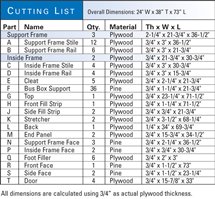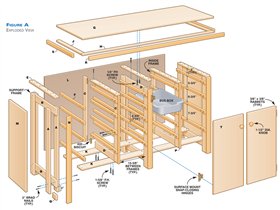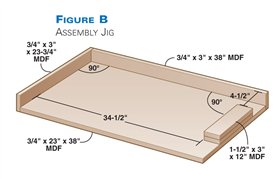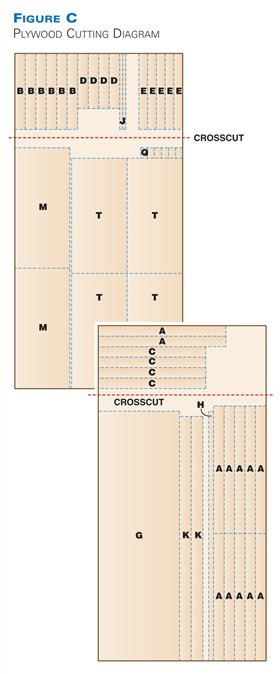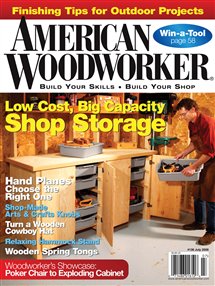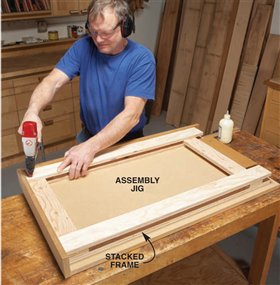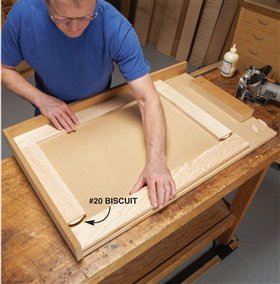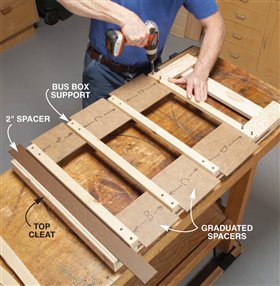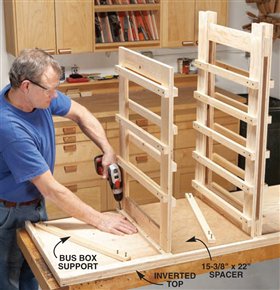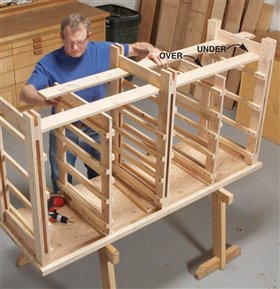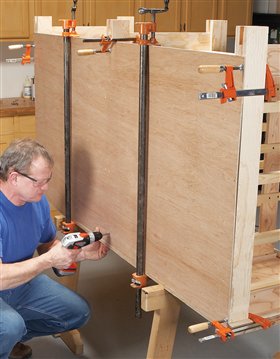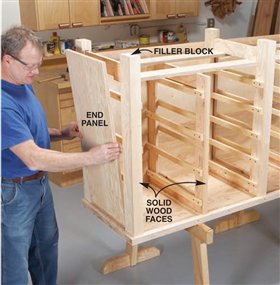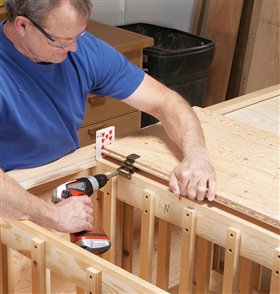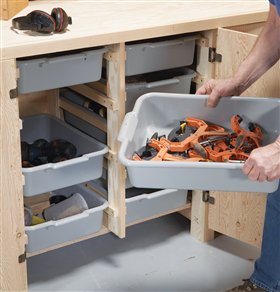When I worked in a restaurant as a teenager, I
hauled dirty dishes in plastic bus boxes. Using
them to organize my shop is much more pleasant. Bus
boxes are light in weight and strong enough to hold all
kinds of shop essentials, including most of my portable
power tools. This 6-ft.-long cabinet holds up to twenty 5 in.
by 15 in. by 20 in. bus boxes (Fig. A, and Sources, below). I built it in a weekend, using an unusual construction
method: Instead of using solid pieces of plywood for all
the elements, I cut the plywood into narrow strips and glued
them back together into structural frames.This method requires less plywood, because so little is wasted.
It’s also a great way to use scrap plywood, because most of
the pieces are relatively short and narrow. The plywood does
not have to be perfectly flat, either, for the same reason.
This method is also versatile. For example, it’s easy to
change the cabinet’s height, the number of storage compartments
or the spacing of the bus boxes. Vary the size of the
frames to create built-in closets and bookcases. For a bedroom,
upgrade to wooden drawers and replace the runners
with full-extension hardware.
This cabinet is made from two 4×8 sheets of 3/4 in. plywood
(I used exterior grade fir). You’ll also need a piece of
1/4 in. plywood or hardboard for the back, an 8 ft. 1×10 to
face all the plywood edges and a 12 ft. 1×12 for the bus box
supports.
Rip the Plywood Parts
1. Lay out all the pieces on the plywood sheets
(Fig. C, Cutting List, below, and Photo 1).
2. Crosscut both plywood sheets into smaller,
more manageable pieces.
3. Cut the stiles, rails and cleats for the structural
frames to final size (Parts A-E, Fig. A). Make
accurate rip cuts; when you add the saw kerfs,
some pieces contain very little waste.
Build the Frames
4. This cabinet includes three support frames
that extend to the floor and two inside frames.
Build the support frames by stacking four stiles and two rails (Photo 2). Use a jig to hold the parts
square during assembly (Fig. B). Glue and
nail the frame’s top inside corner while holding
both stiles against the long fence and the rail against
the short fence. Use 2 in. nails. Secure the bottom
inside joint while holding the rail against both the
fence and the rail alignment block. Make sure the
stiles and rails are flush on the outside when you
glue and nail the outside joints. After nailing all the
joints on one side, flip over the assembly and nail
the joints from the opposite side. Wipe off squeezed
out glue.
5. Assemble the inside frames with biscuits and
glue (Photo 3). Just pull the joints together and let
the frame sit; clamp pressure may distort the frame.
Make Cleats and Box Supports
6. Drill and counterbore the cleats. All of the
cleats are glued and nailed to the top of the frames.
The support frame cleats are also screwed to the
stiles for extra strength.
7. Rip the bus box supports (F) slightly oversized,
joint one edge, plane (or rip) them all to the same
width and then cut them all to the same length.
Assembling the cabinet is easier when the supports
are interchangeable: Use a drill press with a fence
and stop blocks to drill the counterbored screw
holes, so they’re centered and identically located on
both ends of each support.
8. Fasten the supports to the frames, using spacers
for easy and accurate positioning (Photo 4). To
graduate four bus boxes, use 5-3/4 in., 6-3/4 in. and
7-3/4 in. spacers. To space five
boxes evenly, use a 4-3/4 in. spacer.
Always use a 2 in. spacer to position
the top cleat.
Fasten the Frames to the Top
9. Cut the top (G) to final size
and glue fill strips (H and J) on the
bottom. Mark the center of the top
and the center of one support
frame. Line up the marks to locate
the frame, so it’s perfectly centered
and perpendicular to the top’s
front edge. Butt the frame against
the front fill strip—the top should
extend 1/4 in. beyond the frame at
the back—and fasten it to the top
with 1-1/4 in. screws.
10. Use a 15-3/8 in. by 22 in. spacer to locate the
remaining frames—my spacer is 1/4 in. MDF
(Photo 5). You have to remove the top pair of bus box supports to fasten each frame. As the supports
are interchangeable, reinstalling them is a simple
task.
11. Cut the stretchers (K) to final length. The
Cutting List dimensions assume that plywood is exactly
3/4 in. thick, which is rarely true. So measure the
actual rail-to-rail distance on your cabinet to determine
the correct length for the stretchers.
12. Install the stretchers flush with the outside
edges of the bottom rails and fasten them (Photo 6).
13. Use the 15-3/8 in. spacer to position the
remaining frames before fastening the stretchers.
Again, some supports have to be removed and reinstalled.
Final Assembly
14. Fasten the back (L) with screws (Photo 7).
15. Glue on the end panels (M and Photo 8).
Complete the cabinet base by gluing on the frame
faces (N and P) and foot fillers (Q).
16. Finish the top by gluing on the front and side
faces (R and S). The side faces butt against the front
face, which extends beyond the top.
17. Cut the doors (T) to size and round over the
edges. Then saw or rout 3/8 in. by 3/8 in. rabbets
on the long edges only. Install the knobs and
mount all the hinges (see Sources). Then mount
the doors on the cabinet; use seven or eight playing
cards to create a consistent 1/16 in. gap at the
top (Photo 9).
18. Bus up your shop (Photo 10).
Sources
Next Day Gourmet, superprod.com, 800-328-9800, Heavy-
Duty Bus Box, 5” x 15” x 20”, #810619, $11.59 each; Case of 12
Bus Boxes, #812113, $121.
Rockler, rockler.com, 800-279-4441, 1-1/2” Beech Knobs,
#23093, $4.49 per pair, 2 pair req.; 3/8” Inset Hinges, #32122,
$2.69 per pair, 4 pair required.
Cutting List

Fig. A: Exploded View

Fig. B: Assembly Jig

Fig. C: Plywood Cutting Diagram

This story originally appeared in American Woodworker July 2008, issue #136.

|
|
Click on any image to see a larger version.
1. This storage
cabinet
is primarily
made from
plywood—
even the
frames that
support the
bus boxes.
The first step
is to cut the
plywood into
narrow strips
to make stiles
and rails for
the frames.

2. Stacked
support
frames,
with rails
sandwiched
between
the stiles,
go on the
ends of the
cabinet and
in the middle.
They
go together
quickly,
thanks to
an assembly
jig.

3. The two
inside
frames are
biscuited.
To keep the
frames
square, pull
the pieces
together
while holding
the
stiles and
top rail
against the
assembly
jig’s fences.

4. Attach a
cleat on
the top of
each frame.
Then attach
the bus box
supports.
Position all
the top
supports 2
in. from the
cleat. The
rest of the
supports
can go
wherever
you want,
depending
on the
height of
the items
you’ll be
storing.

5. Attach
one support
frame
exactly centered
on the
top. Then
use a spacer
to locate and
attach the
remaining
frames, so
they’re evenly
spaced
and parallel.
You have to
remove the
top bus box
supports to
install each
frame.

6. Tie the
frames
together by
installing the
stretchers.
They pass
under the bottom
rails of
the support
frames and
over the
inside frame
rails. Use the
spacer from
the previous
step to align
the frames
before fastening
them to
the stretchers.

7. Fasten
the
back after
clamping
it flush
with the
cabinet’s
edges and
top.

8. Install the
end panels
to create
a flush surface
(or use
thinner plywood
to
mimic a
recessed
panel). Glue
solid-wood
faces on the
fronts of
each frame
and plywood
filler blocks
in all the
feet.

9. Mount
the
lipped doors,
using a stack
of playing
cards to create
adequate
clearance
between the
doors and
the top. Only
the doors’
long edges
are rabbeted,
as the cabinet
has
solid-wood
facing, rather
than a traditional
face
frame.

10. Install
the
bus boxes.
Durable and
portable,
they’re great
for organizing
all kinds
of tools. |





